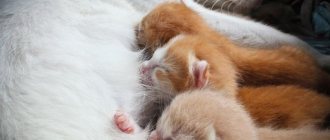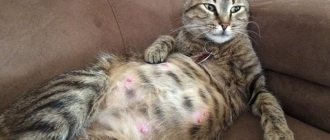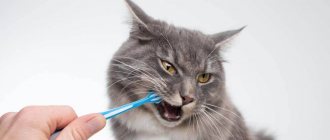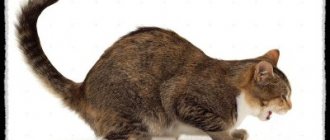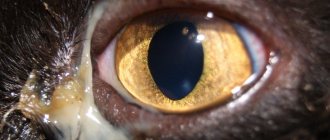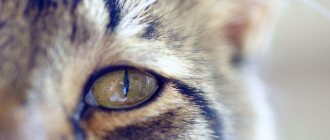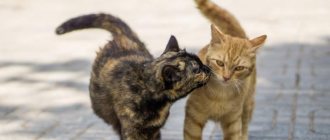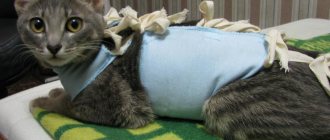Discharge from a cat's loop is a controversial phenomenon, since in some cases it can represent an absolutely normal condition, but in other situations it can be a serious signal of a problem with the pet's health. The most difficult thing in this matter is that it is quite difficult to distinguish abnormal discharge from normal discharge.
As a rule, discharge occurs normally in cats during pregnancy, the birth period, and also after it. Otherwise, if the cat is not pregnant, has not given birth or is breastfeeding, and has discharge, this is a reason to immediately consult a doctor, since the cause of such discharge can be serious illnesses, sometimes even leading to the death of the animal.
Diseases of the reproductive organs
Mucous, cloudy, brown discharge is a sign of glandular cystic endometrial hyperplasia (GCGE). The pathology is caused by hypersecretion of the uterine glands, obstruction of the excretory ducts, and the presence of cysts.
When examining the animal, the following is revealed:
- vulva enlargement
- poor condition of the female
- lethargy, apathy
- lack of appetite
- drinking a lot of water
- dull coat
- enlargement and density of the uterine horns
Mucopurulent excretion can be observed in the purulent form of vulvitis and vaginitis, as a result of penetration of pathogenic bacteria and fungi into the tissues of the vulva and vagina.
Bloody, pus-like discharge from the vagina is a sign of acute endometritis, which, if left untreated, can develop into a more serious form - pyometra.
Pus from the loop is an alarming symptom indicating an inflammatory process in the uterine cavity (open form of pyometra), which can result in the death of the pet. The secreted contents have a yellowish-green or brown tint. Sometimes the discharge becomes heavy and then stops for several days.
Condition of the female:
- general weakness, immobility
- decreased appetite and body weight
- thirst
- nausea, vomiting
- frequent urination
- temperature over 40˚С
- the stomach is enlarged and tense
Contents from the genital slit of a whitish, yellow-green, dark brown hue indicate the presence of a chronic form of endometritis, which developed as a severe consequence of GCGE as a result of the penetration of bacteria from the external genital tract into the uterus.
The general condition of the female is unchanged, but with a complicated course, depression, refusal to feed, increased water consumption, and frequent urination are observed.
Vaginal discharge can occur during prolonged estrus, which is also a pathology and requires examination by a specialist.
Causes of discharge in cats
There are many risk factors that can lead to vaginal discharge:
- vaginal trauma;
- vaginal infection;
- urinary tract infection;
- abnormal cells in the vaginal area;
- preserved placenta after childbirth;
- death of the fetus in the womb;
- the presence of a foreign object in the vaginal cavity;
- estrogen medications prescribed during certain phases of the cat's estrus or estrous cycle; medications;
- certain antibiotics, which may cause vaginal discharge;
Since there are so many causes of this disease, it is recommended to consult a veterinarian if any type of discharge is detected.
Pathologies during pregnancy and childbirth
Bloody black/green discharge during childbirth without any signs of labor is a life-threatening condition for the female.
Possible reasons:
- primary uterine laxity in combination with the death of at least one embryo and separation of the placenta
- death of embryos in the middle or late stages of pregnancy and their blood mummification
Postpartum discharge from the loop (lochia) is normal, but monitoring it is extremely important. Excretion continues from 7 to 30 days, gradually changing color to lighter and decreasing in volume.
In the absence of complications, at first the lochia have a greenish color (the first day), then they become light pink. If they are odorless and not accompanied by high fever, indigestion and other painful symptoms, then there is no reason to worry.
Bloody discharge, or a change in the color of lochia (dirty green, brown) with an unpleasant odor, accompanied by tension in the abdominal wall, symptoms of intoxication, and high temperature should be a reason for an urgent call to a veterinary gynecologist.
Foul-smelling red purulent clots after childbirth are signs of postpartum metritis, which developed as a result of bacteria entering the uterus during childbirth, auxiliary manipulations, retained fetal membranes, and miscarriage.
The female shows signs of intoxication, she is depressed and refuses to eat. Body temperature is high, as evidenced by a hot, dry nose and heavy breathing.
As a result of cessation of lactation, babies cry from hunger and cold. Possible maternal death.
Cat has brown discharge
Vaginal discharge is any substance (such as blood, mucus, pus) that comes out of the vagina through the opening of the vulva.
Ideally, in a healthy cat, vaginal discharge is the result of a natural physiological process in which the secreted mucus lubricates the walls of the internal genital organs and protects them from infections. In the presence of pathology, the color, smell, quantity and consistency of the lubricant change, which allows timely detection of the problem before it worsens.
Free consultation Moscow
+7(495)162-70-70
In some cases, bloody and mucous discharge is normal, but in other cases it is a symptom of inflammation, infection, etc.
- Secretions consisting of serum and blood
Normal – during early estrus, “proestrus” stage; sometimes during “estrus” or in the “estrus” stage.
- Discharge containing blood, mucus and tissue debris (lochia) and other discharge
Normal – postpartum discharge for 6-8 weeks
- Discharge containing pus
Normal – at the beginning of “diestrus” there is a small amount of discharge
When to see a doctor
An attentive and loving owner will immediately notice disturbances in the cat’s behavior and the presence of abnormal discharge after delivery.
Reasons to consult a doctor are:
- Putrid smell.
- Duration of discharge (more than 2 weeks).
- The appearance of white curdled flakes.
- Bleeding or blood clots.
- Feeling unwell with apparently normal discharge.
If any of these signs occur, you should immediately visit a doctor.
Additional symptoms
For different diseases, the following are possible:
- increased and/or difficulty urinating, which is painful and can therefore cause anxiety and even aggression;
- it’s hard for the poor thing to go “big”;
- for a long time the cat rubs its butt on the floor (or rolls on the floor);
- licks himself from behind too often, because the discharge irritates the skin;
- complete apathy; drowsiness; vomit; fever; increased thirst; poor appetite; abdominal enlargement.
Therapeutic techniques
Accordingly, treatment will also depend on the immediate underlying causes:
- If there is pyometra or tumors of any etiology in the uterus, complete surgical removal of the affected organ is recommended. The cat may no longer be able to give birth after this, but her health will be safe.
- In the presence of fistula passages, surgical intervention is also required.
- In almost all cases, broad-spectrum antibiotics are required. This is even used for fungal infections. Although antibiotics do not act directly on the causative agent of the infection, they effectively prevent the development of secondary bacterial infections.
- Accordingly, when fungal pathologies are detected, antifungal agents are prescribed. Please note that they are all very toxic and you will have to (as in the case of antibiotics) feed the kittens yourself. Mother's milk will become poisonous to them.
- For oncology that cannot be surgically removed, chemotherapy or radiotherapy is prescribed.
Let us repeat once again that white discharge from a cat that has given birth is always a reason for a visit to the veterinarian.
Diagnostics
You cannot solve the problem of “brown cat discharge” on your own, so take your pet to a qualified veterinarian. After a couple of questions, your veterinarian will perform a physical test by gently pressing on your pet's glands. Healthy glands should secrete thin yellow fluids, while enlarged glands should secrete thick brown fluids. It is worth noting that you should inform the veterinarian about your pet's condition before admission, such as diarrhea, soft stools,... To rule out other diseases, determine the exact cause and develop an appropriate treatment regimen, the veterinarian will perform chemical testing, including urinalysis, electrolyte analysis, blood test...
© shutterstock
Symptoms of anal sac diseases
Once you understand the nature of anal sac diseases, you can easily monitor the symptoms. Because overcrowded glands cause irritation, cats will lick, run, and perform all sorts of tricks to remove fluid from the inside. In extreme cases, cats may resort to scratching and biting for a purpose that is dangerous.
Since a cat's anal glands are only supposed to secrete fluid during bowel movements, any other type of discharge is a problem. Therefore, if you see traces of brown fluid, your pet has an anal sac disorder.
Treatment
- Only a qualified veterinarian should choose therapy to treat your pet after examination, ultrasound and carefully collected tests.
- If the placenta does not separate for a long time, injections of the hormone oxytocin are used. Only a specialist can correctly determine the dose of medication to protect your pet from unpleasant and painful consequences.
- For severe hemorrhage, vasoconstrictor and hemostatic medications are used.
- For infectious diseases, inflammatory and pathological processes, anti-inflammatory or antibacterial drugs are prescribed.
- For a speedy recovery of your pet, you should pay attention to the quality of its nutrition, a sufficient amount of vitamins and nutrients in it. Sometimes additional multivitamins or immunomodulators are prescribed.
- In particularly difficult cases, surgery is prescribed.
Recommended reading:
What to do if your dog has watery eyes - causes, symptoms, prevention and treatment
Pathological discharge
Even non-specialists understand that bloody watery masses are the most obvious sign of problems with pregnancy. The most dangerous is the light red mucus, which appears every 10–15 minutes, and more than 2 tablespoons comes out at a time. This is already a sign of internal bleeding, which requires surgical intervention. After all, most often such bleeding occurs when the uterus ruptures, which can even be fatal.
Brown or yellow discharge interspersed with blood at the 2nd stage of pregnancy indicates placental abruption or the death of embryos. It is necessary to contact a veterinarian because there are many different options in this situation. For example, if the placenta detaches at a fairly late stage, then the pregnant cat is prescribed additional diagnostics. These are various tests and ultrasound. In the absence of serious problems, constant monitoring is recommended, but, most likely, the pregnancy will end naturally.
If fetal death occurs, there are 3 main treatment options:
- causing premature birth,
- drug therapy,
- surgical intervention.
If a pregnant cat has yellow or green discharge with a strong and unpleasant odor, then one or more embryos have died. Mucus of this color appears when decomposition has already begun. In addition, yellow or green discharge may indicate intoxication in the animal’s internal organs and kidney failure. In these situations, urgent caesarean section or induction of labor is necessary. After this, the cat will have to go through a long period of rehabilitation.
The owner of the animal needs to be careful not to confuse diarrhea with yellow and brown discharge. But at the same time, you should not delay the treatment of such disorders of the digestive system, since in the future even the most minor diseases can affect the health of kittens.
Rules for caring for a cat during the postpartum period
The postpartum period is very important for a cat. What to do to make the animal feel good and the feeding process go smoothly? You will learn about this below.
Hygiene
Hygiene is the first thing you need to pay attention to. As mentioned above, it is necessary to carefully monitor the color and nature of postpartum discharge, and if necessary, wipe the area under the cat’s tail. As a rule, pets after giving birth are already clean - they remove all the mucus themselves, but there are exceptions. But if the cat has just given birth, then she may be too weak to take care of herself.
You also need to pay attention to the place where the cat and kittens lie. To avoid infections that are associated with unsanitary conditions, the area should always be clean. Change the sheets regularly, preferably when the cat goes to the toilet or eats, so as not to disturb its psychological peace.
Peace, only peace
For some time after giving birth, your pet and litter need peace and quiet. Psychological health should be given maximum attention, so it is recommended to place the cat and kittens in a box, which should be placed in a separate room. It is advisable that it be quiet there, and in principle it is not recommended to go there, except perhaps for a person who will monitor the condition of the animal.
Neither adults, nor especially children, should be allowed to touch small kittens. Your pet may behave very unpredictably after this. The cat may stop recognizing the kittens, she may lose milk, or she may even take her offspring to another place and hiss at everyone who tries to approach. Moreover, there have been cases when a cat herself killed kittens, believing that it would not be possible to raise them in such difficult conditions.
Nutrition
One type of food for nursing cats is high-quality Royal Canin
In order for your pet to recover faster during the postpartum period, and therefore for the kittens to feed normally, she must eat enough. The same goes for water. If a cat has brought more than three kittens, then she will eat at least twice as much at a time as usual. This is not fraught with damage to your figure, because all the food consumed will be used to produce milk.
On the first day after giving birth, the cat may not eat anything at all, this is not scary. During this period, she, as a rule, worries about her offspring and pays all her attention exclusively to the kittens. However, your task is to provide the woman in labor with food and drink. You should place bowls of food and water next to the box in which the mother and her offspring are located, because she may express a desire to eat at any time.
As for the diet itself, it is recommended to work it out with a veterinarian. If the cat has always eaten natural food, then the diet must be carefully planned, since a deficiency or excess of a particular substance can negatively affect its health. But if you fed the cat only dry food, then there will be fewer problems. Today, stores sell a wide variety of foods for nursing pets.
If your pet does not eat for more than a day, then you should consult a doctor, because if the cat’s health is normal, then her appetite will be very strong.
Temperature control
You should also monitor your pet’s body temperature, that is, it should be measured periodically, at least once a day, preferably two or even three times. If the animal's temperature is below 38 degrees or above 39, this is very bad. The first thing to do is take your cat to the doctor. If the temperature is above 39 degrees, then most likely this indicates an infection that can kill not only the offspring, but also the mother herself. If the temperature is very low, then this may be a consequence of internal bleeding.
Video “Birth of a kitten”
We do not recommend watching this video for impressionable or faint-hearted people - it shows the process of giving birth to a kitten and how the cat cares for it immediately after birth.
Was this article helpful?
Thank you for your opinion!
The article was useful. Please share the information with your friends.
Yes (100.00%)
No
X
Please write what is wrong and leave recommendations on the article
Cancel reply
Rate the benefit of the article: Rate the author ( 3 votes, average: 5.00 out of 5)
Discuss the article:
What to do
- Swollen glands
In cats with swollen glands, veterinarians first drain fluid with a syringe, clean out the glands, and then administer antibiotics to treat infections. In most cases, your pet can go away after this, but if your cat has chronic swelling, surgical removal of the glands is highly recommended.
In case your cat has strange openings in the anal sac, veterinarians may be able to formulate a treatment regimen based on cyclosporine. Simply put, cyclosporine prevents bacterial infections and is taken orally.
Reminder : Cyclosporine is known to weaken the immune system and, as a result, long-term use of this drug is not recommended. In most cases, it is better to remove the pet's glands instead of controlling the tumor with cyclosporine. Spaying your pet is also a good idea to limit the activity of the anal glands and reduce the frequency of episodes of swelling.
- Torn glands
At this point there is nothing left to do but perform emergency surgery, the vets will remove whatever is left of the glands and clean the area. If the entire operation goes smoothly, the risk of infection should be minimal and a recovery phase will follow. For 1-2 weeks you will need to give your pet an antibiotic prescribed by your veterinarian, but that's it, your pet will be back to his normal self before you know it. As always, return to the clinic periodically to have stitches, staples, etc. removed.
General information
Owners of such pets should strictly distinguish between the fact that there is discharge during gestation of kittens, and there are already prenatal departments. And depending on the time the mucus appears, different actions should be taken.
Cats, like humans, have a cervix. This part of the organ looks like a tube, and during the period when the fetus is not gestating, the neck is tightly compressed due to the work of the muscles. This is done so that various pathogenic microorganisms cannot penetrate into the uterus, because in any situation the internal cavity of the uterus must remain sterile. But during pregnancy, the cervix does not close completely, otherwise in the future it will not be able to relax enough to allow kittens to pass through it.
Therefore, during pregnancy, the cervix is closed by a mucous plug. It helps keep various bacteria, viruses and even air out. If this plug is damaged prematurely, it can lead to problems with the course of pregnancy. But about 5 days before the onset of labor, the plug breaks down on its own, and then brown or yellow mucus may begin to come out.
Prevention of postpartum pathologies
The care and care of the owner largely determines how the cat’s postpartum recovery period will proceed.
What to do:
- Provide a clean birthing area. Immediately after delivery, the cat's birth canal is open for some time. They are entry points for infections. To avoid infection, the animal must give birth in a clean place.
- Remove the afterbirth in a timely manner.
- During pregnancy, examine the cat for internal infections, which may become more active after birth.
- After delivery, carefully monitor the cat’s well-being, feed and drink well, and measure the temperature.
These simple preventive measures will help avoid problems in the postpartum period in cats. If everything is done correctly and carefully, the pet will quickly recover and will delight its owners.
This article has been checked and approved by a veterinarian. Knyazeva Anna Vladimirovna, veterinarian in private practice, Moscow. more about the expert.
(you can vote for the article)
Tags: cat pregnancy, cat discharge, cat health, cat, cat birth
- Related Posts
- Yorkie dog breed. Types of Yorkies
- Signs of worms in cats and remedies for them
- Yorkie's teeth: what care is needed?
